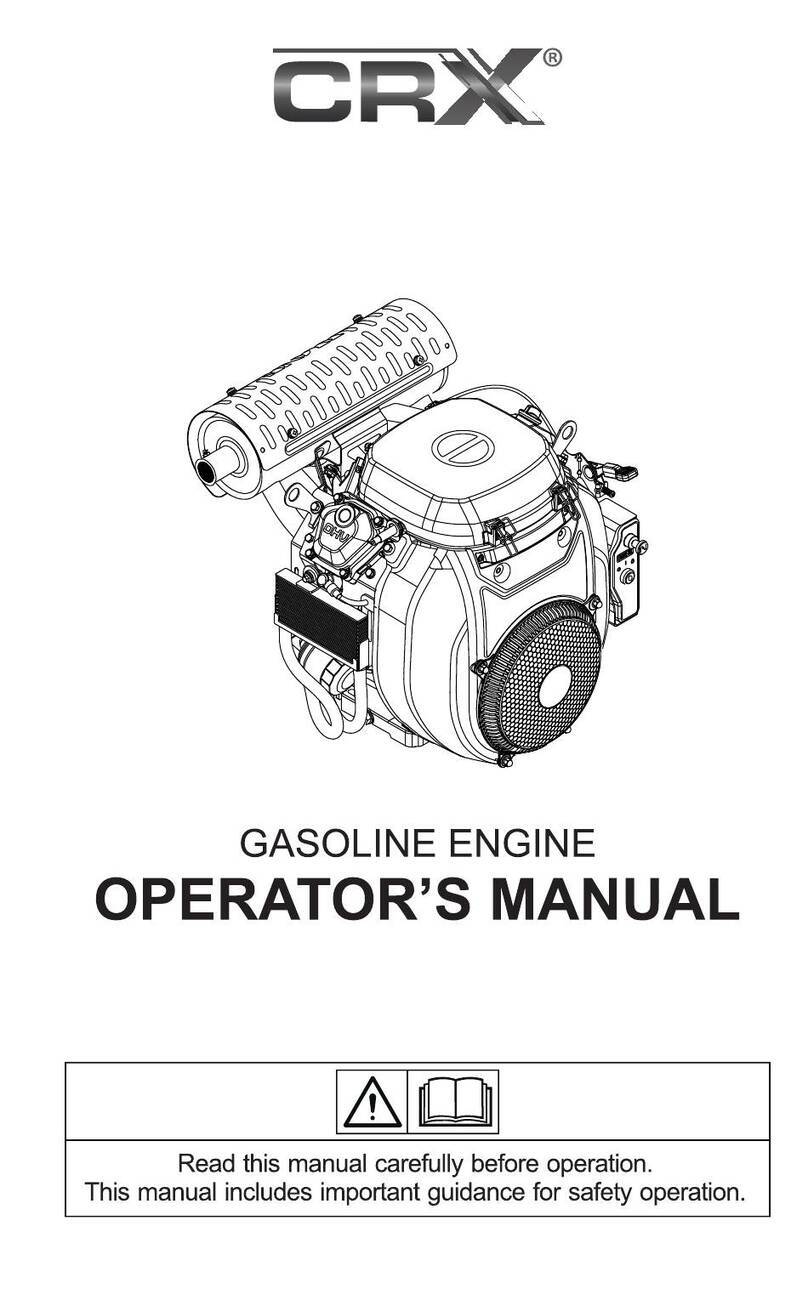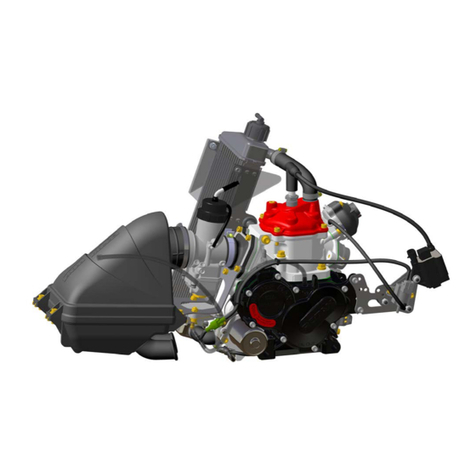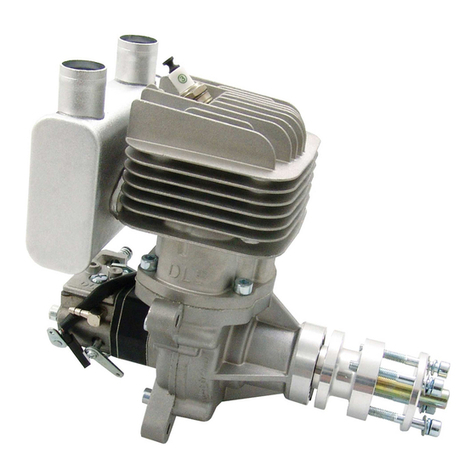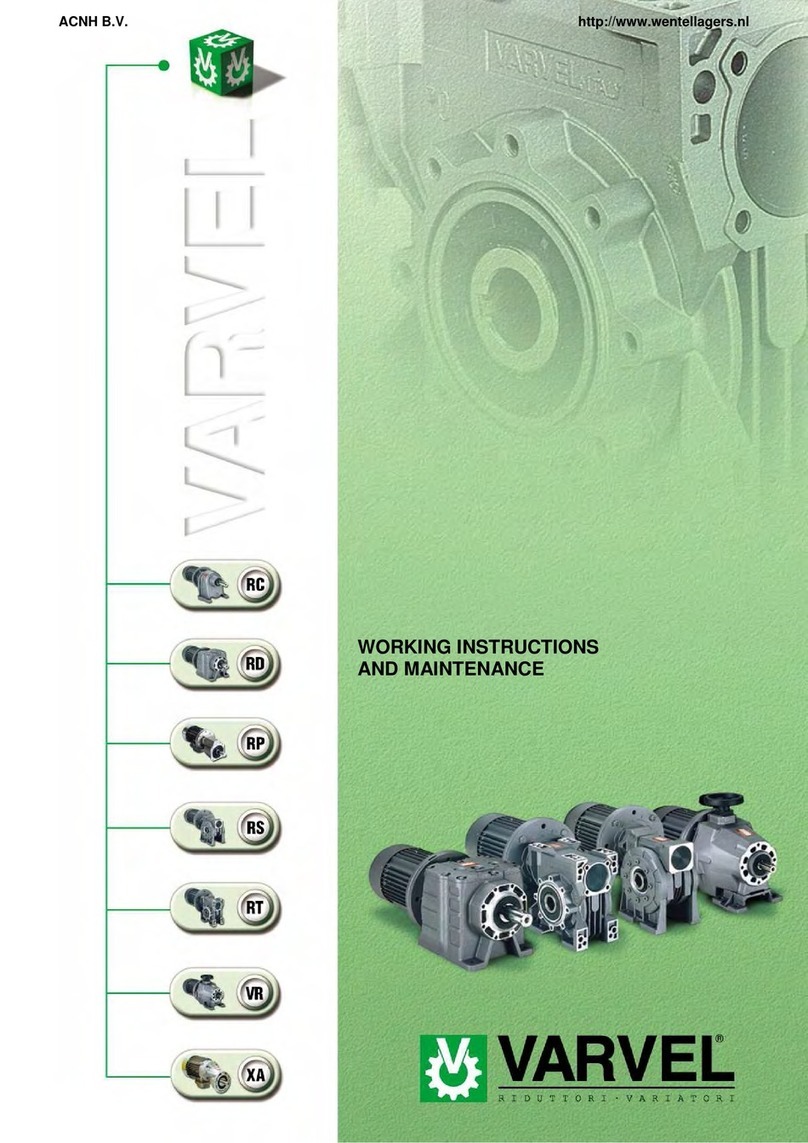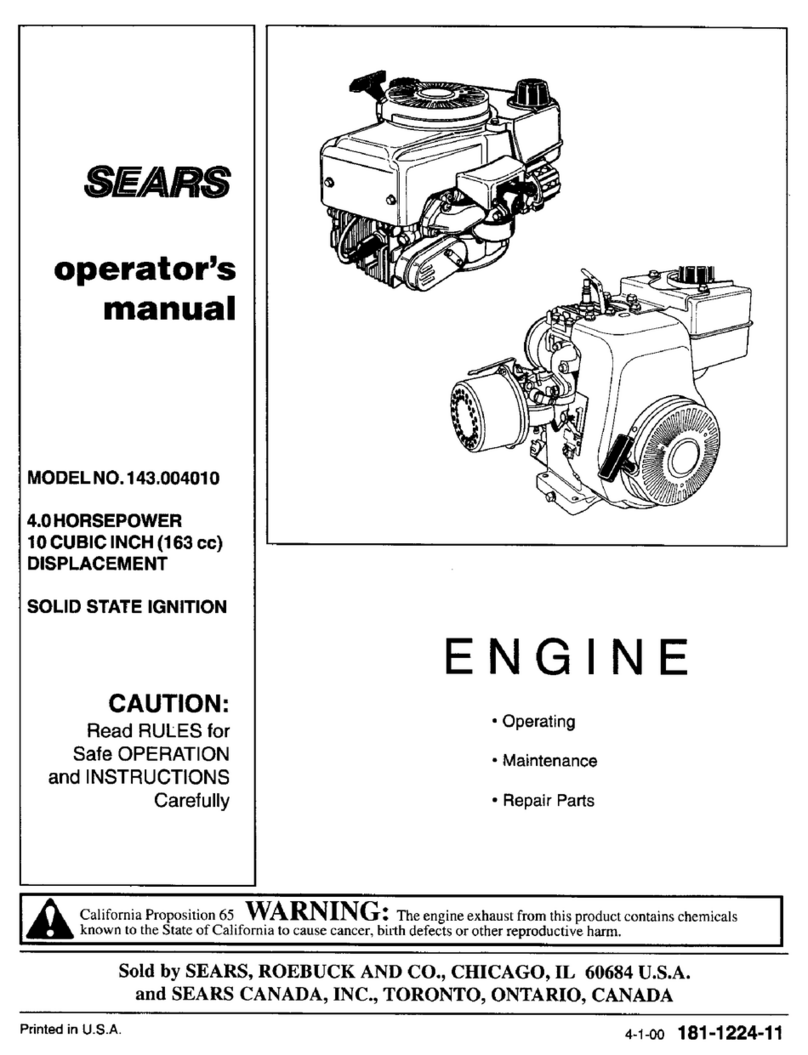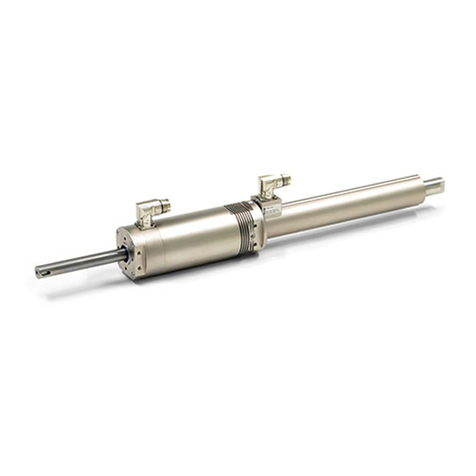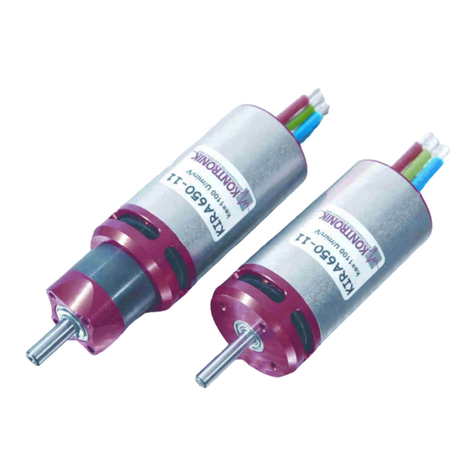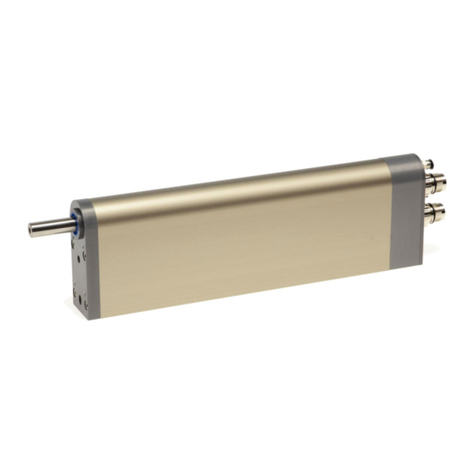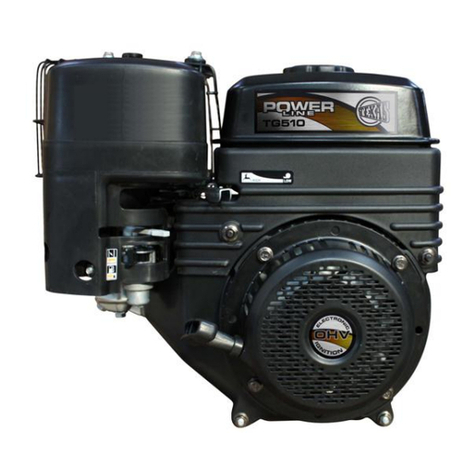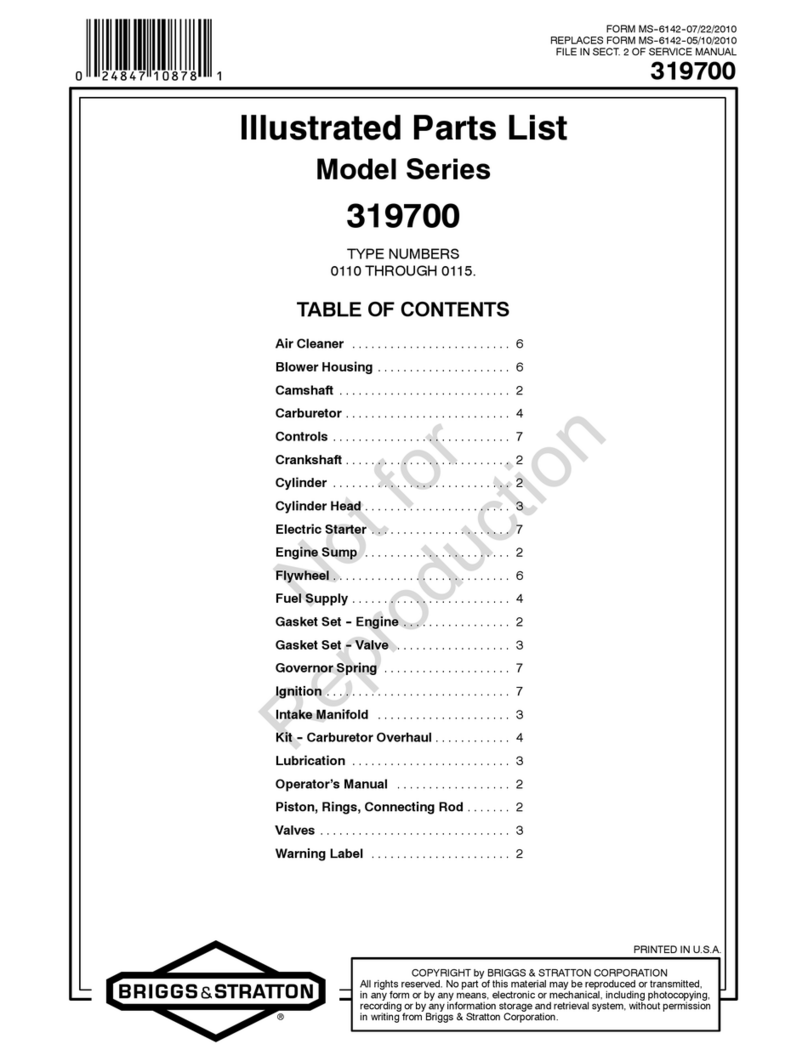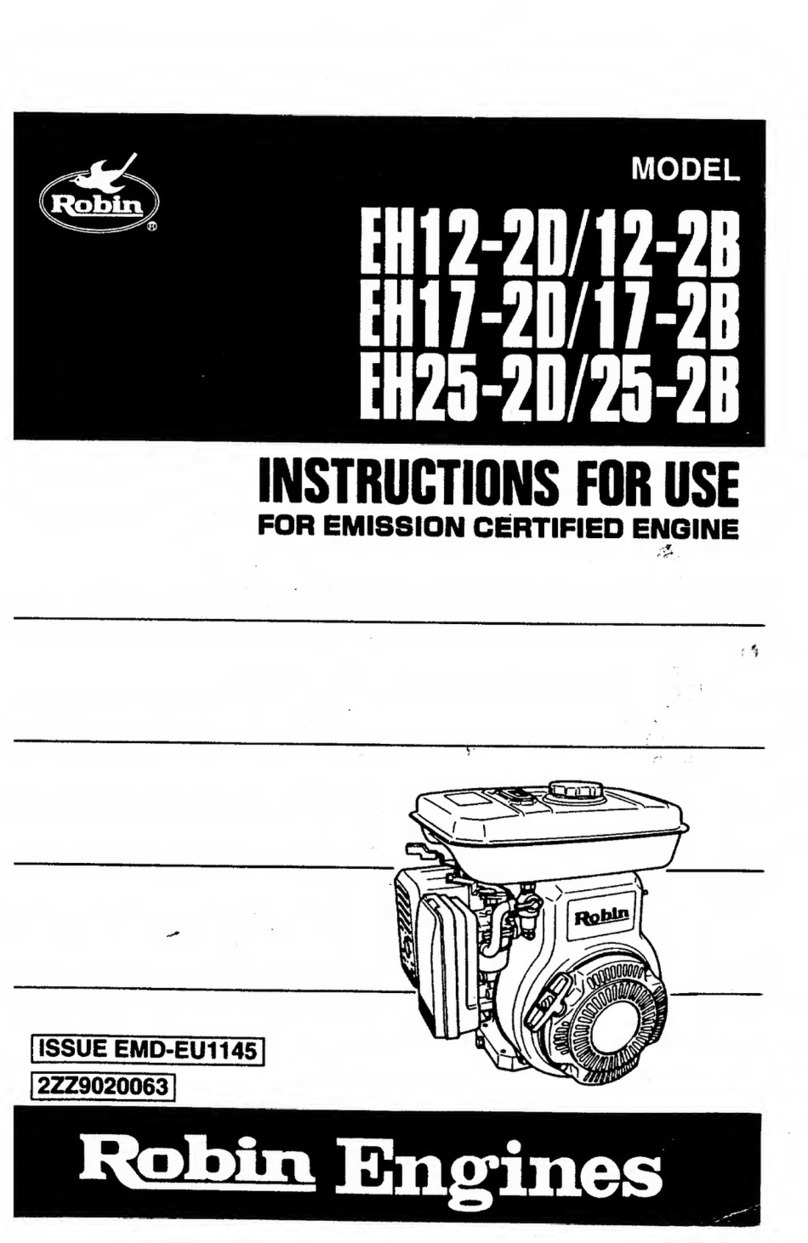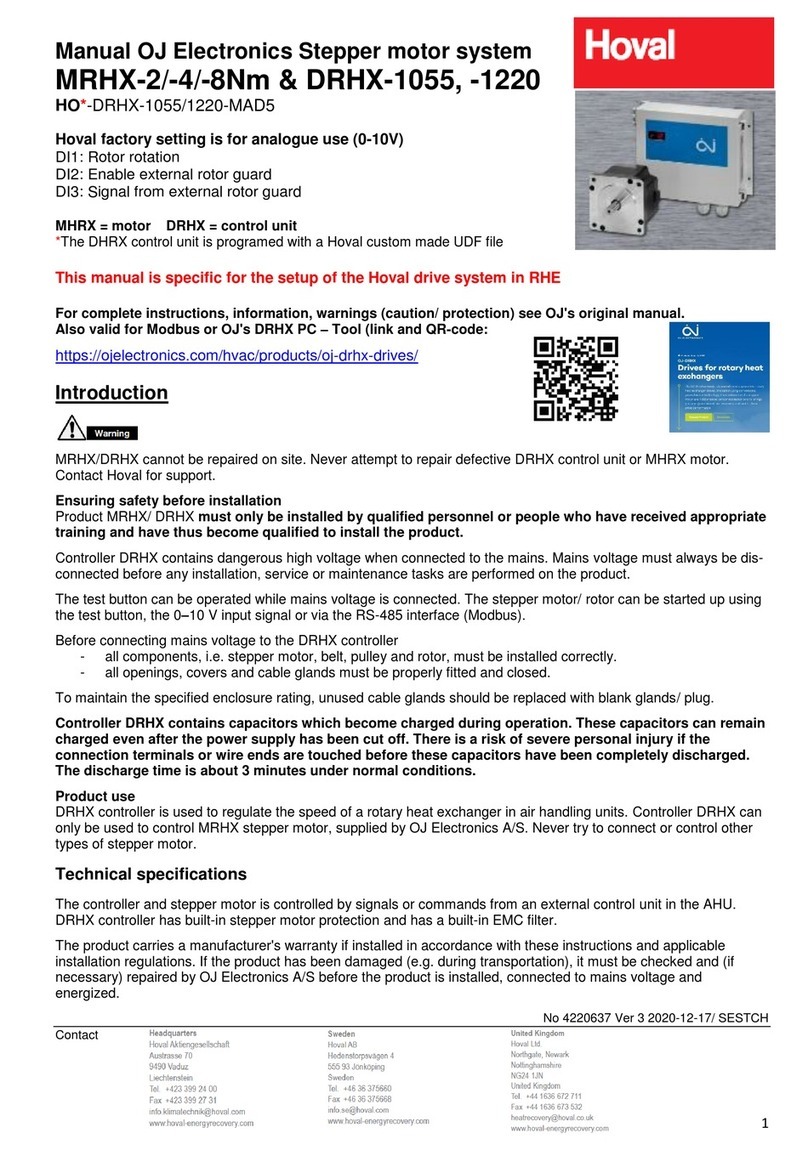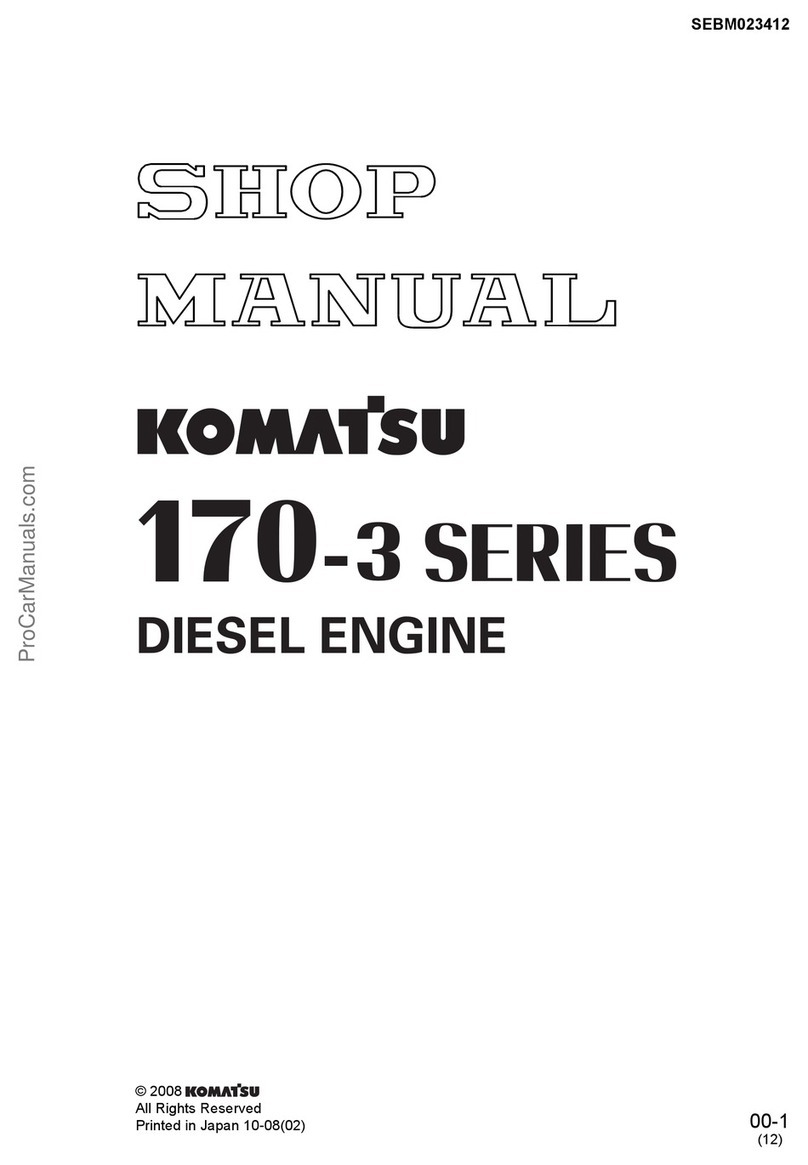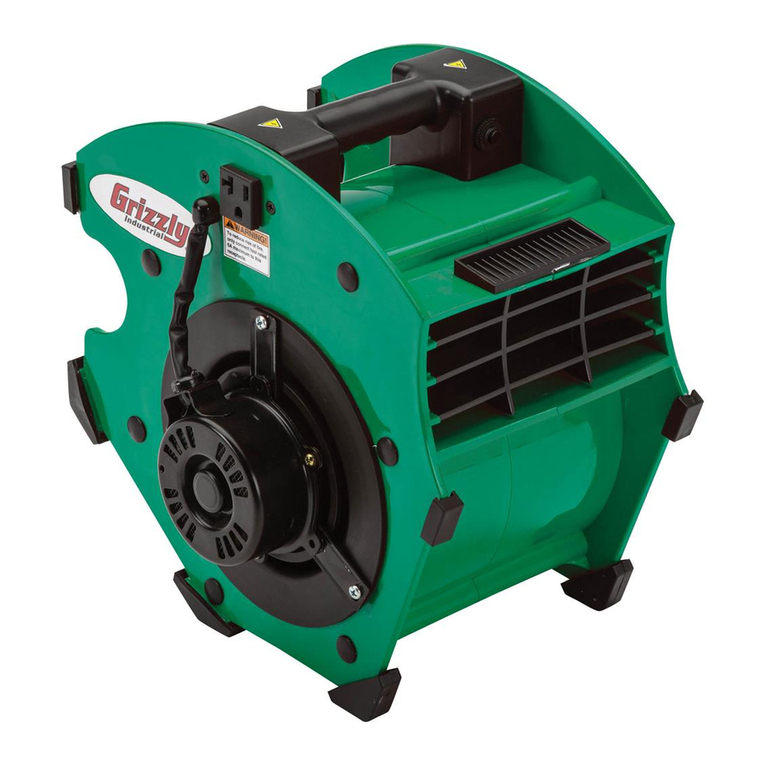GLOW Evolution E777 User manual

E777
E735
E999
GL OW
Evolution®Radial Glow Engines

EN
2
WARNING: Read the ENTIRE instruction manual to become familiar with the features
of the product before operating. Failure to operate the product correctly can result
in damage to the product, personal property and cause serious injury.
This is a sophisticated hobby product and NOT a toy. It must be operated with caution and
common sense and requires some basic mechanical ability. Failure to operate this Product in a
safe and responsible manner could result in injury or damage to the product or other property.
This product is not intended for use by children without direct adult supervision. Do not attempt
disassembly, use with incompatible components or augment product in any way without the
approval of Horizon Hobby, Inc. This manual contains instructions for safety, operation and
maintenance. It is essential to read and follow all the instructions and warnings in the manual,
prior to assembly, setup or use, in order to operate correctly and avoid damage or serious injury.
CAUTION: This product can become extremely hot when in use, which could lead
to burns.
Age Recommendation: Not for children under 14 years. This is not a toy.
Safety Warnings
Model engines produce a substantial amount of power, which can create unsafe situations if not
used correctly. Always use common sense and observe all safety precautions when operating,
handling or performing any procedure involving your engine. Failure to follow safety precautions
could result in serious injury and property damage.
• Always ensure spectators, especially children, are at least 30 feet away when running
the engine.
• Always ensure that the propeller is securely attached to the engine shaft and all retaining
fasteners are tightened properly before EACH flight. Use of blue threadlock to tighten nuts
is advisable.
• Always keep small parts out of the reach of children as they can be choking hazards.
• Always secure the airplane before powering the engine.
• Always keep your face and body away from the path of the propeller blades when starting
or running your engine.
• Always stand behind the propeller when making carburetor adjustments.
• Always wear safety glasses or goggles when starting and running your engine.
• Always keep your fuel in a safe place away from sparks, heat or anything that can ignite.
NOTICE
All instructions, warranties and other collateral documents are subject to change at the sole
discretion of Horizon Hobby, Inc. For up-to-date product literature, visit horizonhobby.com
and click on the support tab for this product.
The following terms are used throughout the product literature to indicate various levels
of potential harm when operating this product:
NOTICE: Procedures, which if not properly followed, create a possibility of physical property
damage AND a little or no possibility of injury.
CAUTION: Procedures, which if not properly followed, create the probability of physical
property damage AND a possibility of serious injury.
WARNING: Procedures, which if not properly followed, create the probability of property
damage, collateral damage, serious injury or death OR create a high probability of
superficial injury.
Meaning of Special Language

EN
3
• Always ensure the aircraft is secure and will not move once the engine is started.
• Always rebind your transmitter to your receiver(s) after setup and before rst ight.
• Always ensure the throttle failsafe is set to low throttle in your transmitter.
• Always perform a range check prior to ight.
• Always cut off the fuel supply (pinch or disconnect the fuel line to the carburetor)
or use the throttle linkage to shut off the air in order to stop the engine.
• Never use hands, ngers, or any other body part to stop the propeller.
• Never throw any object into a propeller to stop it.
• Never run the engine in the vicinity of loose small objects, such as gravel or sand, to avoid
the propeller uncontrollably throwing such materials.
• Never wear loose clothing or a loose neckstrap when operating your model engine as these
items could become entangled in the propeller.
• Never have loose objects such as screwdrivers, pencils, etc. in your pockets when operating
your model engine. These could fall into the propeller.
• Never allow fuel to come into contact with eyes or mouth. Gasoline and other fuels used
in model engines are poisonous.
• Always ensure gasoline and fuel are stored in a clearly marked container away from the
reach of children.
Precautionary Guidelines
• Always mount the engine securely on a bench mount or high-quality engine mount.
• Always use the correct size and pitch of propeller for your engine. Refer to the Propeller Chart
in this manual.
• Always conrm proper balance of your propeller prior to installation of the engine.
Failure to do so could result in damage to the engine and/or the airframe.
• Always utilize an electric starter when possible to start your engine after checking for
hydraulic lock in the cylinders.
• Always discard any propeller that is nicked, scratched, cracked or damaged in any way.
• Always run your model engine in a well-ventilated area. Model engines may produce possibly
harmful carbon monoxide fumes.
• Always store your fuel safely in a sealed, water-resistant container.
• Always store fuel in a cool, dry location. Do not allow fuel containers to come in direct contact
with concrete, as the fuel may absorb moisture.
• Always responsibly discard fuel if there is condensation and/or water inside the fuel
container.
• Never return unused fuel from the fuel tank back into the fuel container.
• Never attempt to repair or modify a propeller beyond its intended use.
• Never handle model engines, mufers and/or tuned pipes until they have had time to cool.
They can become extremely hot when in use.

EN
Introduction
Thank you for purchasing an Evolution®radial engine, one of the finest engines in the market-
place today. Evolution is committed to you having a positive experience and a lifetime of great
operation with your new engine.
It is important that you read the engine manual before starting the engine for the first time.
Evolution radial engines have different requirements than engines that you may have operated
in the past. The manual provides important information for installing the engine, selecting the
correct propeller and proper engine break-in procedures.
Engine Specifications
EVOE735 EVOE777 EVOE999
cylinders 7 7 9
capacity 2.1 cu in (34.9cc) 4.7 cu in (77cc) 6.0 cu in (99cc)
capacity per cylinder 0.3 cu in (5.0cc) 0.66 cu in (11cc) 0.66 cu in (11cc)
bore 0.71 in (18mm) 0.93 in (23.7mm) 0.93 in (23.7mm)
stroke 0.79 in (20mm) 0.98 in (25mm) 0.98 in (25mm)
power 2.2hp 4.8hp 6.0hp
crankshaft thread size 8 x 1mm 10 x 1mm 10 x 1mm
RPM range 1000–6300 1000–6000 1000–6000
maximum RPM 6700 6300 6300
engine diameter 7.3 in (185mm) 9.1 in (23 cm) 10.2 in (26 cm)
engine length 6.3 in (159mm) 7.9 in (20 cm) 7.9 in (20 cm)
weight 3.1 lb (1.4 kg) 5.7 lb (2.6 kg) 7.7 lb (3.5 kg)
fuel usage (approx.) 1.0 oz (28 ml)/min 2.2 oz (62 ml)/min 2.8 oz (80 ml)/min
propellers 2-Blade
17 x 8, 17 x 10,
17 x 12, 18 x 8
2-Blade
22 x 12, 24 x 10
3-Blade
22 x 10
2-Blade
26 x 10, 24 x 12
Needed to Complete
• Propeller • Engine bafes
• Fuel line (3mm or 3.5mm ID) • On-board glow driver (optional)
• Engine mounting screws • Glow driver battery
(1.2V 6000–9000mAh Ni-MH battery required)
Installing the Engine in the Airframe
Properly installing the engine to either the airframe or an engine test stand for break-in is crucial
to getting the most power and longest life from your engine.
WARNING: Always attach the engine mounting ring to a flat plate surface, such as
6–8mm plywood or carbon ber plate.
WARNING: Never use a standoff between the rewall and the mounting ring. Vibration
between the standoff and the mounting ring will damage the mounting ring and cause
the engine to separate from the airframe.

EN
5
1. Install the engine on the airframe with Cylinder
#1 in the top (12:00) position (Cylinder #1 is
above the Evolution Engines logo). You can
modify this position if you are using the op-
tional collector ring and you want the exhaust
to exit the cowl in a specific direction.
10-15mm
3. Relieve the rewall to make sure there is
at least 10–15mm (3/8–5/8 in) separation
between the carburetor and the firewall
for smooth airflow to the carburetor and to
allow adequate movement of the choke plate.
E
V
O
L
U
T
I
O
N
2
3
45
6
7
1
2. Use three steel screws (not included) to attach
the engine mounting ring to the firewall. The
size of the mounting ring screws will vary
depending on the aircraft. Always use the
largest size screw that will fit through the
mounting ring.
To keep the engine from coming loose in flight:
Firewall with blind nuts installed: Always
use split washers between the mounting
ring screws and the mounting ring.
Firewall with through bolts installed:
Always use nylon locking nuts with bolts
through the firewall.

EN
6
4. Make sure the fuel tank is no farther than 100mm (4 in) from the back of the rewall.
The center of the fuel tank should be in line with the carburetor to prevent fuel siphoning.
• You do not need to use a fuel pump with Evolution radial engines
• Always use a fuel lter inside the fuel tank
• We recommend using medium (3mm) or large (3.5mm) inner diameter fuel line
• Make sure there are no sharp bends in the fuel line between the fuel tank and the engine.
5. Attach the throttle servo linkage to the throttle bellcrank on the engine mounting plate.
Attaching the Included Glow Plug Harness
Your engine includes a 7- or 9-cylinder glow plug harness. Attach the red wired harness to
each of the cylinders and run the battery lead to a convenient mounting point for your glow
plug connector. We recommend installing the glow plug connector in the cowl or the side of
the fuselage. Remove one of the rear crankcase cover bolts. Attach the black wire to the bolt
and install the bolt in the crankcase cover.
Keep the overall length of both the red and black glow harness wires as short as possible
so the highest possible voltage will reach your glow plugs.
Glow Plug Starting Battery
The starting battery or on-board battery (whichever you prefer) should be a 1.2 V 6000–8000
mAh battery pack. We’ve had success building a pack of (6) 1300–1600 mAh NiCd (preferred)
or NiMh (takes longer to cycle to full capacity) 1.2v battery cells wired in parallel so the total ca-
pacity is 7800–9600 mAh. The total draw on 7 glow plugs at 2.2–2.7 amps per plug is 15.4–18.9
amps. With a 7800–9600mAh battery pack, you can expect about 30 minutes of ‘on-time’.
Once the engine is broken in, you will likely find that the engine idles and runs very well
without an on-board battery.
Installing On-Board Glow Drivers
Although Evolution Radial engines run just fine without constant glow heat applied, the use
of on-board glow drivers allows for easier engine starting and can ensure adequate heat in the
glow plugs at all times. This is particularly important on radial engines where oil collects in the
lower cylinders. SonicTronics/McDaniel RC on-board glow systems work very well with Evolution
radial engines.
7-cylinder applications: MCD477
9-cylinder applications: MCD479
We recommend installing the glow driver socket on the side of the cowl or fuselage and keeping
the battery wires as short as possible. Longer wires between the battery pack and the glow
drivers will reduce the amount of glow plug heat.
Attach the ground wire to one of the engine backplate screws or the crankcase.
Engine Cooling Requirements
It is very important to consider adequate cooling inside the airplane cowl. Engines require
a cooling airow exhaust:intake ratio of 3:1 to 5:1. A large open cowl may lead you to believe
there is adequate cooling; however, you must make sure air is flowing through the cowl and
the cylinder head fins. Achieving the proper ratio typically requires cowl and/or engine
baffles to reduce the open intake area.
1. Ensure there is adequate cooling air moving through the cylinder head cooling ns.
The intake air tends to move through the path of least resistance (between the cylinders)
instead of through the cylinder cooling fins.

EN
7
2. If necessary, add baffles to the engine to prevent air from moving between the cylinders.
Engine baffles force cool air through the cooling fins and greatly reduce the intake area
in the front of the cowl.
3. Add cooling bafes to the engine cowl between the top of the cylinder heads and the inside
of the cowl. Do not cover the engine exhaust pipe with the baffles. This needs cool air over
it to prevent exhaust valve damage.
Propeller Selection
Propeller selection is critical for proper engine operation. You can nd recommended propel-
lers and operating RPM ranges in the specification chart. Evolution radial engines have a lower
operating RPM range and greater torque within that range that require more blade pitch and
increased in-air pitch speed for your airplane.
To increase climbing and acceleration: Increase propeller diameter and decrease blade pitch.
To increase top speed: Decrease propeller diameter and increase blade pitch.
Make sure the propeller is securely mounted to the crankshaft before attempting to start
the engine.
1. Remove the wire circlip from the crankshaft in front of the propeller nut.
2. Install the propeller on the crankshaft.
3. Secure the propeller with the hexagonal nut.
4. Securely fasten the circlip on the outside of the hexagonal nut.
WARNING: NEVER start the engine without the circlip securely fastened. Doing so may
result in serious injury, as the propeller may become loose once the engine is started.
Fuel Selection
Evolution radial engines only require 6–7% synthetic oil after the break-in process. There is no
need to use fuel with nitro content higher than 10%. Adding additional oil to the fuel will reduce
the engine RPM. Please refer to the following chart for fuel recommendations.
Depending upon your choice of oil, you may nd that the engine feels ‘dry’ at the end of a ight
when using 6–7% oil. If you want, you can use 8–9% oil with any mix of ying fuel.
Tip: Many users combine one gallon of a good quality 15% nitro fuel (with 18% oil content)
with a gallon of pure methanol to achieve a 7 1/2% nitro and 9% oil mixture.
methanol % synthectic oil % nitro %
break-in
1st hour 90%10%0%
2to 3hours 92%8%0%
flying without nitro
1st hour 93%7%0%
2to 3hours 94%6%0%
flying with nitro
1st hour 88%7%5%
2to 3hours 83%7%10%

EN
8
Engine Break-In Process
A good break-in process is essential to the longevity and performance of your Evolution radial
engine. You can complete the break-in process by either mounting the engine on a test stand
or on an airframe. If you choose to mount the engine on an airframe, remove the cowl during
break-in to ensure adequate cooling.
Specific fuel is required for the break-in process. Please refer to the chart above for the proper
fuel. Break-in fuel contains additional oil compared to fuel you will use for everyday flying. The
additional oil is critical for cooling and removing break-in debris from the engine.
During break-in, run the engine for 3–4 minutes at a time, allowing the engine to cool between
runs. Vary the throttle between idle and ¾ throttle for the rst 30 minutes of engine run time.
The engine break-in process will be complete after the rst 3 hours of engine run time and
you can begin tuning the engine for normal flying.
Checking for a Flooded Cylinder
Because of the nature of radial engines it is not uncommon for the lower cylinders to accumulate
excess fuel or oil either in storage or during the priming process. Before beginning the starting
process be sure to:
1. Rotate the propeller by hand. During the rotation, if you encounter a point where there is seri-
ous resistance to the rotation, STOP. This is an indication of a flooded cylinder and what you
are feeling is hydraulic lock. Any further attempts to force the rotation of the engine can result
in damage to the cylinder or conrod.
2. If you encountered hydraulic lock, remove the glow plug from the lower two cylinders and the
engine should rotate freely. Continue to rotate until all the excess fluid has been removed
from the cylinder.
3. Reinstall the glow plug and continue with the starting process.
Starting the Engine
Use a high quality gear oil to lubricate the outer parts of the valve train at the beginning
of each flying day.
1. Fill the fuel tank with fuel.
2. Power off or disconnect the glow driver.
3. Make sure the fuel lines are properly connected to the carburetor.
4. Open the throttle to full open. The carburetor barrel should be fully opened.
5. Place the choke lever over the carburetor opening.
6. Rotate the propeller 3 or 4 times until you see fuel moving through the fuel lines.
7. Remove the choke lever from the carburetor opening and move the throttle stick to ¼ throttle.
8. Power on or connect the glow driver battery. Make sure the glow driver battery is
fully charged.
9. Start the engine with an electric starter.

EN
9
Engine Tuning
The break-in settings for the carburetor needles are:
High-speed needle: 2 1/2 turns open
Tip: For the initial break-in, open the high speed needle to 1-1/2 turns before starting.
Low-speed needle: 2 turns open
Use a tachometer (HAN111 or HAN156) to tune the engine based on RPM.
WARNING: Always adjust the carburetor from behind the propeller. Keep all loose
items away from the propeller at all times. Never reach over or around the propeller.
1. Start the engine.
2. Move the throttle stick up until the engine is running at approximately 2,000 rpm.
3. If you are using separate exhaust pipes, use a temperature gun to make sure hot exhaust
is exiting all engine cylinders. If using a collector ring, make sure that each cylinder is of
a similar temperature to the others, indicating that it is running.
4. Move the throttle stick up to full (open) throttle.
If the engine runs rough or if some cylinders are not operating, the fuel mixture is too rich.
Lower the rpm to approximately to 2000 and lean the high speed needle valve by 1/8 of a turn.
5. Repeat Step 4 until the engine is running reliably at full (open) throttle. Proceed with the
break-in process described above.
High-Speed Needle Tuning
Once the engine is running reliably at full (open) throttle:
1. Lean the high-speed needle 1–2 clicks at a time.
2. Wait 2–3 seconds for the engine to respond. Radial engines do not respond immediately
to tuning changes.
a. If there is an increase in RPM: Lean the high-speed needle an additional 2 clicks and
wait for the engine to respond to the tuning change. If there is no increase in RPM after
the change, turn the high-speed needle back to its previous position.
b. If there is a decrease in RPM: Richen the high-speed needle 4 clicks and wait for
the engine RPM to stabilize.
3. Repeat Step 2 until you determine the maximum RPM with the fuel and propeller
you selected.
4. Richen the high-speed needle until the RPM lowers approximately 10% of the maximum
RPM (Example: If the maximum is 6,500 RPM, richen the high-speed needle until the RPM
drops to 5,900 RPM). Richening the high-speed needle allows the RPM to increase when
the airplane is flying. Further adjustments can be made after flying the engine to fine-tune
this needle position. This is a safe place to start to avoid overheating and an engine
flame-out.
Low-Speed Needle Adjustment
Low-speed needle adjustment controls the fuel/air mixture at idle and the quality
of the transition between idle and wide open throttle.
Tip: The use of an on-board glow driver will hide the effects of a poor low-speed needle
setting. When you are tuning the low-speed needle, turn the on-board glow driver off and
on to check the engine RPM response at idle.

EN
10
Test
1. Allow the engine to run at idle with the on-board glow driver ON. Observe the engine RPM.
2. Turn the on-board glow driver OFF.
If the engine RPM immediately drops, the low-speed needle is too rich. Lean the low-speed
needle (turn clockwise).
If the engine continues to run at the same RPM with the on-board glow driver OFF,
the low-speed needle setting is close to ideal.
Low-Speed Needle Tuning
1. Adjust the high-speed needle for the current conditions.
2. With the on-board glow system off (if using one) or the glow starting battery disconnected, al-
low the engine to idle for 10–15 seconds. Rapidly advance the throttle from idle to full open.
If the engine transitions with no hesitation, the low-speed needle is adjusted perfectly.
If the engine slowly responds to throttle change and gradually reaches peak RPM, the
low-speed needle is too rich. Lean out the low-speed needle (turn clockwise) 1/8 turn
and test again.
If the engine immediately stops running, the low-speed needle is lean. Richen the low-speed
needle 1/8 turn and test again.
3. When the low-speed needle is adjusted correctly, check the high-speed needle setting again.
4. When you are satisfied with the needle settings, you should not need to adjust the low-
speed needle again. The low-speed needle setting is mechanically controlled and it does
not change with atmospheric conditions.
Maintenance
There are a few things you must do to ensure proper operation of your Evolution radial engine.
1. Use a high-quality gear oil to lubricate the outer parts of the valve train at the beginning
of each flying day.
2. Use a high-quality, after-run oil such as Evolution Blue Block (EVOX1001 or EVOX1002) at
the end of each day’s flying. After-run oil protects the inside of the engine from corrosion
and un-burnt fuel in the crankcase.
How to Apply Evolution Blue Block After-Run Oil
1. At the end of the ying day, empty the fuel tank.
2. Attach the glow starting battery to the plugs, and, with the engine at the normal starting
throttle position, start the engine.
3. With the throttle at idle, allow the engine to die of fuel starvation.
4. With the throttle still at idle, restart the engine and allow it to die. Repeat as necessary
until the engine will not start. You have now insured that most all of the un-burnt fuel is
out of the engine crankcase.
5. Remove the glow heat.
6. Remove one of the pushrods from the number one cylinder and then remove the
cam follower pin. You now have access to the crankcase to insert the after-run oil.
7. Insert 5–10ml of EVO Blue Block After-Run Oil through the cam follower guide.
8. With the throttle wide open and no glow heat applied, rotate the engine with an electric
starter, or by hand, through 8–10 revolutions to disperse the oil throughout the engine.
9. Replace the cam follower pin and the pushrod. Leave the throttle wide open. Your
engine is now ready for short term storage and awaits its next day at the field.

EN
11
Evolution Blue Block After-Run Oil has been proven to provide long term protection against
corrosion when applied immediately at the end of the flying day. Even waiting overnight
before applying after-run oil will greatly increase the chances of corrosion within your engine.
Take care of your investment. Please do not believe the claims of the fuel companies that
claim “No need to use after-run oil”. They don’t own your engine!
3. Occasionally, you will need to adjust the valves. Adjust the valves the rst time after one
hour of engine run time. After the first hour, monitor the valve lash and adjust the valves
as needed. Adjust the valves when the engine is cool. The lash is set at 0.1mm–0.25mm
at the factory.
Evolution Radial Valve Adjustment Guidelines
1. Place the engine in a position (on or off your airplane) that allows you easy access
to the valves on all the cylinders.
2. Remove the glow plugs from all the cylinders. It is much easier to determine Top Dead
Center (TDC) without the compression caused by installed glow plugs.
3. Attach a propeller or other turning device (such as a short block of wood with the
appropriate hole for the crankshaft) to the crankshaft and tighten it so you can easily
rotate the crankshaft throughout this process.
4. Start with the number 1 cylinder (this should be the upright cylinder above the
Evolution logo).
a. Rotate the crankshaft counter-clockwise and observe the pushrod movement.
b. Note when you see the exhaust and then the intake pushrod move up to open
the valves. This will occur during one rotation of the crankshaft.
c. When the piston reaches the top of the cylinder during the next rotation,
you are at the TDC of the compression/firing stroke.
d. Position the piston at TDC of the compression/firing stroke. It is helpful to place
a short piece of wooden dowel. (Don’t use steel, as you can mar the inner surface
of the cylinder.)
5. Use a feeler gauge to check the valve lash between the rocker arm and the top
of the valve.
a. We recommend setting the valve lash as close to 0.1mm as possible. If the valve lash
is between 0.1 and 0.15mm (.004–.006”), you do not need to adjust the valve lash.
The settings for the intake and exhaust valves are the same.
b. Adjust the valves by loosening the locking nut and adjusting the screw until you can
just feel the drag of the .1mm (.004”) feeler gauge as you pull it between the valve
and rocker arm.
c. Tighten the locking nut and recheck the valve clearance. Sometimes when tightening
the nut, the adjustment will change slightly.
6. Because the cam gear of our engines is a shared cam gear with all the cylinders and
rotates at a 1:6 ratio, there are actually 6 different positions on the cam gear that need to
be checked. Repeat step 4 & 5 above four more times to check each of these positions. If
you find that the valve lash is smaller, readjust that valve. If it is greater, do not readjust
the valve. A little loose is safer than too tight.
7. Now move onto the next cylinder in an counter-clockwise directions and repeat steps
4 through 6. Do this for all cylinders.
Congratulations. You have now completed the valve adjustment process. This
maintenance should not be required again for another 10 hours of running time.

EN
12
Replacement Parts
NOTICE: If a repair outside of normal maintenance as noted in the manual is required, you
MUST send the engine to an authorized Horizon Service Center for repair. Any repair work
performed outside of an authorized Horizon Service Center will void the warranty.
Component Name EVOE735 EVOE777 EVOE999
Propeller Washer EVO73501 EVO77701 EVO77701
Propeller Drive EVO73502 EVO77702 EVO77702
Propeller Nut EVO73529 EVO77729 EVO77729
Prop Drive Lock Cone EVO73535 EVO77735 EVO77735
Push Rod and Pin EVO73516AEVO77716AEVO99916A
Rocker Arm Sub-Assembly EVO73527AEVO77727AEVO77727A
Inlet and Exhaust Pipe Sub-Assembly EVO73534AEVO77734AEVO99934A
Carburetor Sub-Assembly EVO735115 EVO777115AEVO777115A
Carburetor Rebuild Kit EVO735115AEVO777106AEVO999106A
Silencer Ring EVO735114 EVO777114 EVO999114
Glow Harness Assembly EVO735120 EVO777120 EVO999120

EN
13
Exploded View
Optional Silencer Ring
(not included)
Rocker Arm
Sub-Assembly
Inlet and Exhaust
Pipe Sub-Assembly
Carburetor Sub-Assembly
Push Rod and Pin
Prop Drive Lock Cone
Propeller Drive
Propeller Nut
Propeller Washer

EN
14
1 Year Limited Warranty
What this Warranty Covers
Horizon Hobby, Inc., (Horizon) warranties that
the Products purchased (the “Product”) will
be free from defects in materials and work-
manship for a period of 1 years from the date
of purchase by the Purchaser.
What is Not Covered
This warranty is not transferable and does not
cover (i) cosmetic damage, (ii) damage due
to acts of God, accident, misuse, abuse, neg-
ligence, commercial use, or due to improper
use, installation, operation or maintenance,
(iii) modication of or to any part of the Prod-
uct, (iv) attempted service by anyone other
than a Horizon Hobby authorized service
center, or (v) Products not purchased from
an authorized Horizon dealer.
OTHER THAN THE EXPRESS WARRANTY ABOVE,
HORIZON MAKES NO OTHER WARRANTY OR
REPRESENTATION, AND HEREBY DISCLAIMS
ANY AND ALL IMPLIED WARRANTIES, INCLUD-
ING, WITHOUT LIMITATION, THE IMPLIED WAR-
RANTIES OF NON-INFRINGEMENT, MERCHANT-
ABILITY AND FITNESS FOR A PARTICULAR
PURPOSE. THE PURCHASER ACKNOWLEDGES
THAT THEY ALONE HAVE DETERMINED THAT
THE PRODUCT WILL SUITABLY MEET THE
REQUIREMENTS OF THE PURCHASER’S
INTENDED USE.
Purchaser’s Remedy
Horizon’s sole obligation and purchaser’s sole
and exclusive remedy shall be that Horizon
will, at its option, either (i) service, or (ii)
replace, any Product determined by Horizon to
be defective. Horizon reserves the right to in-
spect any and all Product(s) involved in a war-
ranty claim. Service or replacement decisions
are at the sole discretion of Horizon. Proof of
purchase is required for all warranty claims.
SERVICE OR REPLACEMENT AS PROVIDED
UNDER THIS WARRANTY IS THE PURCHASER’S
SOLE AND EXCLUSIVE REMEDY.
Limitation of Liability
HORIZON SHALL NOT BE LIABLE FOR SPECIAL,
INDIRECT, INCIDENTAL OR CONSEQUENTIAL
DAMAGES, LOSS OF PROFITS OR PRODUCTION
OR COMMERCIAL LOSS IN ANY WAY, REGARD-
LESS OF WHETHER SUCH CLAIM IS BASED IN
CONTRACT, WARRANTY, TORT, NEGLIGENCE,
STRICT LIABILITY OR ANY OTHER THEORY OF LI-
ABILITY, EVEN IF HORIZON HAS BEEN ADVISED
OF THE POSSIBILITY OF SUCH DAMAGES. Fur-
ther, in no event shall the liability of Horizon
exceed the individual price of the Product on
which liability is asserted. As Horizon has no
control over use, setup, final assembly, modi-
fication or misuse, no liability shall be as-
sumed nor accepted for any resulting damage
or injury. By the act of use, setup or assembly,
the user accepts all resulting liability. If you
as the purchaser or user are not prepared to
accept the liability associated with the use
of the Product, purchaser is advised to return
the Product immediately in new and unused
condition to the place of purchase.
Law
These terms are governed by Illinois law
(without regard to conict of law principals).
This warranty gives you specific legal rights,
and you may also have other rights which vary
from state to state. Horizon reserves the right
to change or modify this warranty at any time
without notice.
Warranty Services
Questions, Assistance, and Services
Your local hobby store and/or place of pur-
chase cannot provide warranty support
or service. Once assembly, setup or use of the
Product has been started, you must contact
Horizon directly. This will enable Horizon to
better answer your questions and service
you in the event that you may need any as-
sistance. For questions or assistance, please
direct your email to productsupport@hori-
zonhobby.com, or call 877.504.0233 toll free
to speak to a Product Support representative.
You may also nd information on our website
at www.horizonhobby.com.
Inspection or Services
If this Product needs to be inspected or ser-
viced, please use the Horizon Online Service
Request submission process found on our
website or call Horizon to obtain a Return
Merchandise Authorization (RMA) number.
Pack the Product securely using a shipping
carton. Please note that original boxes may be
included, but are not designed to withstand
the rigors of shipping without additional
protection. Ship via a carrier that provides
tracking and insurance for lost or damaged
parcels, as Horizon is not responsible for mer-
chandise until it arrives and is accepted at our

EN
15
facility. An Online Service Request is available
at http://www.horizonhobby.com under the
Support tab. If you do not have internet ac-
cess, please contact Horizon Product Support
to obtain a RMA number along with instruc-
tions for submitting your product for service.
When calling Horizon, you will be asked to
provide your complete name, street address,
email address and phone number where you
can be reached during business hours. When
sending product into Horizon, please include
your RMA number, a list of the included items,
and a brief summary of the problem. A copy
of your original sales receipt must be included
for warranty consideration. Be sure your
name, address, and RMA number are clearly
written on the outside of the
shipping carton.
Notice: Do not ship LiPo batteries to
Horizon. If you have any issue with a LiPo
battery, please contact the appropriate
Horizon Product Support office.
Warranty Requirements
For Warranty consideration, you must include
your original sales receipt verifying the
proof-of-purchase date. Provided warranty
conditions have been met, your Product will
be serviced or replaced free of charge. Service
or replacement decisions are at the sole
discretion of Horizon.
Non-Warranty Service
Should your service not be covered by
warranty service will be completed and pay-
ment will be required without notification or
estimate of the expense unless the expense
exceeds 50% of the retail purchase cost. By
submitting the item for service you are agree-
ing to payment of the service without notifica-
tion. Service estimates are available upon
request. You must include this request with
your item submitted for service. Non-warranty
service estimates will be billed a minimum of
½ hour of labor. In addition you will be billed
for return freight. Horizon accepts money
orders and cashiers checks, as well as Visa,
MasterCard, American Express, and Discover
cards. By submitting any item to Horizon for
service, you are agreeing to Horizon’s Terms
and Conditions found on our website http://
www.horizonhobby.com/Service/Request/.
Contact Information
Horizon Hobby Address Phone Number/Email Address
United
States
Horizon
Service Center
(Electronics
and engines)
4105 Fieldstone Rd
Champaign, Illinois
61822 USA
877-504-0233
Online Repair Request:
www.horizonhobby.com/service
Horizon
Product Support
(All other products)
4105 Fieldstone Rd
Champaign, Illinois
61822 USA
877-504-0233
productsupport@horizonhobby.com
United
Kingdom
Horizon Hobby
Limited
Units 1-4 Ployters Rd
Staple Tye
Harlow, Essex
CM18 7NS
United Kingdom
+44 (0) 1279 641 097
sales@horizonhobby.co.uk
Germany Horizon
Technischer
Service
Christian-Junge-
Straße 1
25337 Elmshorn
Germany
+49 (0) 4121 2655 100
service@horizonhobby.de
France Horizon
Hobby SAS
14 Rue Gustave Eiffel
Zone d’Activité du
Réveil Matin
91230 Montgeron
+33 (0) 1 60 47 44 70
infofrance@horizonhobby.com

DE
16
HINWEIS
Alle Anweisungen, Garantien und dazugehörigen Dokumente können ohne Ankündigung
von Horizon Hobby Inc. geändert werden. Eine aktuelle Version ersehen Sie bitte im
Support Feld unter: http://www.horizonhobby.com.
Die folgenden Begriffe werden in der gesamten Produktliteratur verwendet, um auf
unterschiedlich hohe Gefahrenrisiken beim Betrieb dieses Produkts hinzuweisen:
HINWEIS: Wenn diese Verfahren nicht korrekt befolgt werden, können sich möglicherweise
Sachschäden UND geringe oder keine Gefahr von Verletzungen ergeben.
ACHTUNG: Wenn diese Verfahren nicht korrekt befolgt werden, ergeben sich wahrscheinlich
Sachschäden UND die Gefahr von schweren Verletzungen.
WARNUNG: Wenn diese Verfahren nicht korrekt befolgt werden, ergeben sich wahrscheinlich
Sachschäden, Kollateralschäden, schwere Verletzungen oder Tod ODER mit hoher Wahrs-
cheinlichkeit oberflächliche Verletzungen.
ERKLÄRUNG DER BEGRIFFE
WARNUNG: Lesen Sie die GESAMTE Bedienungsanleitung, um sich vor dem Betrieb mit
den Produktfunktionen vertraut zu machen. Wird das Produkt nicht korrekt betrieben,
kann dies zu Schäden am Produkt oder persönlichem Eigentum führen oder schwere
Verletzungen verursachen.
Dies ist ein hochentwickeltes Hobby-Produkt. Es muss mit Vorsicht und gesundem Menschen-
verstand betrieben werden und benötigt gewisse mechanische Grundfähigkeiten. Wird dieses
Produkt nicht auf eine sichere und verantwortungsvolle Weise betrieben, kann dies zu Verletzun-
gen oder Schäden am Produkt oder anderen Sachwerten führen. Versuchen Sie nicht ohne
Genehmigung durch Horizon Hobby, Inc., das Produkt zu zerlegen, es mit inkompatiblen Kompo-
nenten zu verwenden oder auf jegliche Weise zu erweitern. Diese Bedienungsanleitung enthält
Anweisungen für Sicherheit, Betrieb und Wartung. Es ist unbedingt notwendig, vor Zusammen-
bau, Einrichtung oder Verwendung alle Anweisungen und Warnhinweise im Handbuch
zu lesen und zu befolgen, damit es bestimmungsgemäß betrieben werden kann und
Schäden oder schwere Verletzungen vermieden werden.
ACHTUNG: Dieses Produkt kann bei dem Betrieb extrem heiß werden was zu
Verbrennungen führen kann.
Alters Empfehlung: Nicht für Kinder unter 14 Jahren. Das ist kein Spielzeug.
Sicherheitswarnungen
Modellmotoren haben eine erhebliche Leistung, die bei unsachgemäßer Verwendung eine Ge-
fährdung darstellen kann. Nutzen Sie bei dem Betrieb immer den gesunden Menschenverstand
und beachten alle Sicherheitshinweise bei dem Umgang mit dem Motor, oder allen Tätigkeiten
in diesem Zusammenhang. Das nicht befolgen der Sicherheitsbestimmungen kann zu ernst-
haften Personen- und Sachbeschädigungen führen.
• Stellen Sie immer sicher dass Zuschauer, insbesondere Kinder, mindestens 9,90 Meter
entfernt sind wenn Sie den Motor laufen lassen.
• Stellen Sie vor JEDEM Flug sicher, dass der Propeller fest mit der Kurbelwelle verbunden ist
und alle Halter/Befestigungen sicher angezogen/befestigt sind. Verwenden Sie zum sichern
von Schrauben und Muttern blauen Schraubensicherungslack.
• Halten Sie Kleinteile immer aus der Reichweite von Kindern, da diese verschluckt
werden können.
• Sichern Sie immer das Flugzeug bevor Sie den Motor starten.

DE
17
• Halten Sie immer das Gesicht und den Körper weg vom Propellerkreis wenn Sie den Motor
starten oder wenn er läuft.
• Stellen Sie sich immer hinter den Propeller wenn Sie Einstellungen am Vergaser vornehmen.
• Tragen Sie immer eine Schutzbrille beim Starten oder Laufen lassen des Motors.
• Bewahren Sie ihren Kraftstoff immer an einem sicheren Ort weit weg von möglicher
Funkenbildung, Hitze oder zündfähigen Stoffen auf.
• Stellen Sie immer sicher, dass das Luftfahrzeug korrekt gesichert ist und sich bei Motorstart
nicht bewegen/anrollen kann.
• Führen Sie nach den Einstellungen vor dem Erstug den Bindevorgang erneut aus.
• Stellen Sie immer sicher dass die Failsafeeinstellung des Gaskanal auf Motor aus/
Leerlauf steht.
• Führen Sie immer vor dem Flug einen Reichweitentest durch.
• Unterbrechen Sie die Kraftstoffversorgung (durch trennen oder abdrücken der
Kraftstoffleitung) oder schließen Sie mit Gasgestänge die Vergaserdrosselklappe
um den Motor zu stoppen.
• Gebrauchen Sie niemals Ihre Hände, Finger oder andere Körperteile um den Propeller
zu stoppen.
• Werfen Sie niemals etwas in den Propeller um ihn zu stoppen.
• Lassen Sie niemals den Motor über losen Untergrund wie Sand oder Kies laufen, damit
nicht die Gefahr besteht dass der Motor kleine Teile unkontrolliert hochschleudert.
• Tragen Sie niemals bei dem Betrieb des Modells lose Kleidung oder ein loses Nackenband/
Umhängegurt, da sich diese Teile im Propeller verfangen können.
• Führen Sie niemals bei Betrieb oder Umgang mit dem Motor lose Gegenstände wie
Schraubendreher, Stifte, etc.. in Ihren Taschen. Diese könnten in den Propeller fallen.
• Lassen Sie niemals Kraftstoff in Berührung mit Mund oder Augen kommen da dieser giftig ist.
• Lagern Sie Kraftsoff in eindeutig bezeichneten Behältnissen ausserhalb der Reichweite
von Kindern.
Sicherheitsrichtlinien
• Montieren Sie den Motor korrekt auf einer geeigneten Werkbank oder einem qualitativ
hochwertigen Motorträger.
• Verwenden Sie immer Propeller mit der richtigen Größe und Steigung. Sehen Sie dazu
in die Propellerliste in dieser Anleitung.
• Überprüfen Sie immer vor der Montage des Propellers dass dieser einwandfrei gewuchtet ist.
Das nichtbeachten könnte zu Motorschäden oder zu Schäden am Flugzeug führen.
• Verwenden Sie immer falls möglich einen Elektrostarter.
• Verwenden Sie keine Propeller die Knicke, Risse, Brüche oder sonstige Beschädigungen
aufweisen.
• Lassen Sie den Motor nur in gut belüfteten Bereichen laufen. Modellmotoren produzieren
giftige Kohlenmonoxid Abgase.
• Lagern Sie Kraftstoff nur in kühlen trockenen Orten. Lassen Sie Kraftstoffbehälter nicht in di-
rekten Kontakt mit Beton kommen, da der Kraftstoff dadurch Feuchtigkeit aufnehmen könnte.
• Entsorgen Sie immer verantwortungsvoll Kraftstoff der durch Kondensation Feuchtigkeit
(Wasser) aufgenommen hat.
• Schütten Sie niemals ungebrauchten Kraftstoff aus dem Tank in den Kanister.
• Modizieren, verändern und reparieren Sie niemals Propeller.
• Hantieren Sie nicht mit Modellmotoren, Schalldämpfern, Auspuffen oder Resorohren
bis diese vollständig abgekühlt sind. Diese können bei Betrieb extrem heiß werden.

DE
Einleitung
Wir möchten uns sehr herzlich für den Kauf dieses Evolution Sternmotors bedanken. Dieser
Motor ist einer der Besten den Sie heute am Markt erhalten können. Wir sind davon überzeugt,
dass Sie mit diesem Motor sehr positive Erfahrungen machen werden und lange Freude
daran haben.
Bevor Sie den Motor das erste Mal starten ist es wichtig, dass Sie diese Bedienungsanleitung
sorgfältig lesen. Evolution Sternmotoren haben andere Anforderungen als andere Motoren
die Sie vielleicht in der Vergangenheit betrieben haben. Diese Bedienungsanleitung gibt ihnen
wichtige Informationen für den Einbau, die Auswahl des richtigen Propellers und das richtige
Einlaufen lassen.
Motorspezikationen
EVOE735 EVOE777 EVOE999
Zylinder 7 7 9
Hubraum 34.9cc 77cc 99cc
Hubraum pro Zylinder 5.0cc 11cc 11cc
Bohrung 18mm 23.7mm 23.7mm
Hub 20mm 25mm 25mm
Leistung 2.2hp 4.8hp 6.0hp
Kurbelwellengewinde 8 x 1mm 10 x 1mm 10 x 1mm
Drehzahlbereich 1000–6300 1000–6000 1000–6000
Maximale Drehzahl 6700 6300 6300
Motordurchmesser 185mm 23 cm 26 cm
Motorlänge 159mm 20 cm 20 cm
Gewicht 1.4kg 2.6kg 3.5kg
Kraftstoffverbrauch 28 ml 62 ml 80 ml/min
Propeller 2-Blatt: 17 x 8,
17 x 10, 17 x 12, 18 x 8
2-Blatt: 22 x 12,
24 x 10
3-Blatt: 22 x 10
2-Blatt: 26 x 10,
24 x 12
Sie benötigen noch
• Propeller
• Kraftstoffschlauch
• Motorhalterschrauben
• Motorbleche
• eingebautes Glühsystem (optional)
• Zündkerzenakku
(1,2 Volt 6000 - 9000 mAh NiMH Akku)
Einbau des Motors im Rumpf
Montieren Sie den Motor zum Einlaufen lassen korrekt im Rumpf oder auf einem Motorprüfstand
um die beste Leistung und Langlebigkeit zu erhalten.
WARNUNG: Schrauben Sie den Motormontagering immer auf eine flache Oberfläche
wie 6 - 8mm Sperrholz oder eine Kohlefaserplatte.
WARNUNG: Verwenden Sie zwischen Motormontagering und Motorspant keine
Distanzhülsen. Die Vibrationen zwischen Distanzhülse und Montagering beschädigen
den Ring und trennen den Motor vom Rahmen.

DE
19
1. Montieren Sie den Motor im Rumpf mit dem
Zylinder Nr. 1 auf der 12:00 Position. (Zylinder
Nr. 1 ist über dem Evolution Logo).
Sie können diese Position mit dem option-
alen Kollektorring modizieren wenn Sie den
Auspuff an einer bestimmen Stelle durch die
Cowling (Motorhaube) führen wollen.
10-15mm
3. Lassen Sie zum Brandschott vom Vergaser
min 10- 15mm Abstand um einen guten Lufts-
trom und Bewegungsfreiheit des Chokehebels
zu ermöglichen.
E
V
O
L
U
T
I
O
N
2
3
45
6
7
1
2. Verwenden Sie drei Stahlschrauben (nicht
im Lieferumfang) um den Motorhalter an das
Brandschott zu schrauben. Die Größe der
Schrauben variieren abhängig vom Flugzeug.
Verwenden Sie immer die größte Schrauben-
größe die durch den Ring paßt.
Um den Motor am lösen zu hindern:
Brandschott mit Einschlagmuttern:
Verwenden Sie immer Federringe
zwischen Schrauben und Montagering.
Brandschott mit Bolzen:
Verwenden Sie immer Nylon Stopmuttern
mit Bolzen durch das Brandschott.

DE
20
4. Stellen Sie sicher, dass der Kraftstofftank nicht weiter als 100mm von der Rückseite des
Brandschottes entfernt ist. Die Mitte des Kraftstofftankes sollte dabei auf einer Linie mit
dem Vergaser sein, um ein Absaugen des Kraftstoffes vom Motor weg zu verhindern.
• Sie benötigen bei Evolution Stermotoren keine Kraftstoffpumpe.
• Verwenden Sie immer einen Kraftstofflter im Tank.
• Wir empfehlen die Verwendung von 3,0 mm oder 3,5mm (Innendurchmesser)
Kraftstoffschlauch.
• Stellen Sie bitte sicher dass keine scharfen Knicke im Kraftstoffschlauch zwischen
Tank und Motor sind.
5. Montieren Sie das Gasgestänge an dem Gaswinkelhebel auf der Motormontageplatte.
Anschluß des Glühkerzensteckers
Ihr Motor wird mit einem 7 oder 9 Zylinder Glühkerzensteckerkabel geliefert. Schließen Sie das
rote Kabel an jeden einzelnen Zylinder an und führen den Akkuanschluß an den Glühkerzena-
kkuanschluß. Wir empfehlen den Glühkerzenanschluß in der Motorhaube oder an der Seite des
Rumpfes zu montieren. Schrauben Sie eine der hinteren Kurbelwellengehäusebolzen los und
befestigen Sie den schwarzen Draht daran. Schrauben Sie den Bolzen wieder fest.
Halten Sie die Länge des roten und schwarzen Kabel so kurz wie möglich, dass die höchste
Stromspannung die Kerzenstecker erreicht.
Glühkerzenakku
Der Start oder Bordakku (was Sie bevorzugen) sollte 1,2 V 6000 - 8000 mAh Kapazität haben.
Ein guter Weg ist ein Paket von 6 Zellen 1300 - 1600mAh NiCad (vorzugsweise) oder NiMH (diese
brauchen einen längeren Zyklus bis zur vollen Kapazität) parallel geschaltet, dass die Gesamt-
kapazität 7800 - 9600mAh beträgt. Der Stromverbrauch der sieben Glühkerzen bei 2,2 bis 2,7 A
beträgt 15,4 bis 18,9A. Mit einem 7800 - 9600mA Akku haben Sie so eine nutzbare Zeit von 30
Minuten. Nach dem Einlaufen lassen werden Sie feststellen, dass der Motor auch ohne Bord-
glühzündung sauber und ruhig läuft.
Montage des Bordglühkerzenanschluß
Obwohl Evolution Sternmotoren auch ohne konstant beheizte Glühkerzen laufen bringt die
Verwendung eines Bordglühkerzenaschlusses ein einfacheres Starten. Das ist bei Sternmotoren
wichtig bei dem sich Öl in den unteren Zylinder sammeln kann. Das Bord Glühsystem von
SonicTronics/McDaniel arbeitet sehr gut mit Evolution Stermotoren.
7 Zylinder: MCD477
9 Zylinder: MCD479
Wir empfehlen den Glühkerzenanschluß auf der Seite der Cowling oder des Rumpfes
einzubauen um die Kabelzuleitungen so kurz wie möglich zu halten.
Verbinden Sie das Massekabel mit einer Kurbewellengehäuseschraube.
Kühluftanforderungen
Es außerordentlich wichtig dass Sie für eine adäquate Kühlung unter der Cowling sorgen. Der
Motor benötigt ein Auslass/Einlass Verhältnis vom 3:1 bis 5:1. Eine große offene Cowling (Mo-
torhaube) kann Sie zu der Annahme bringen, dass ausreichen Kühlluft eintritt, Sie müssen aber
auch davor sorgen dass sie durch die Cowling an den Zylinderköpfen strömt. Das Erreichen des
richtigen Verhältnis erfordert Luftleitbleche in der Cowling um die offene Fläche zu reduzieren.
1. Stellen Sie sicher dass ausreichende Kühlluft die Kühlrippen der Zylinder erreicht. Luft hat
die Eigenschaft den Weg des geringsten Wiederstandes zwischen den Zylindern zu wählen
statt den Weg zwischen den Kühlrippen.
This manual suits for next models
2
Table of contents
Languages:
